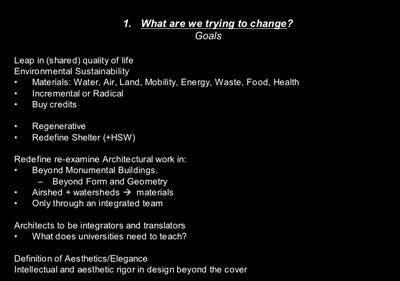|
|
Leap in the shared quality of life is one. The second was environmental sustainability, which includes a long list of things. This point covered a lot of the materials, water, air, land, mobility, energy, waste, food, health. Throughout the session we talked about whether we were able to accomplish radical change or whether this was just all incremental change.
Clearly the sentiment was that the incremental change was too slow and we needed radical change. Were any of the improvements in the research projects that we were suggesting really just incremental change? Were we getting a little bit better or were any of them really aiming for the goal of radical change. I'm not sure we did it, but it was a goal that we had.
We just want to make sure the concept of radical change is out on the table. We were interested in a regenerative architecture: redefining shelter, redefining the role of housing through welfare and what architects need to do to address that. We were really interested in redefining the realm that architects had to work that were beyond the monumental buildings, beyond just form and geometry.
We did talk about things like working with watersheds, really integrating through all of the different materials and technologies that were available. We thought that architects could be both integrators and translators. What would that mean for the universities and the architects who had to play that role? There were some discussions about aesthetics, which tied into some of the things about metrics and whether the idea of elegance, which was raised in the second talk, and efficiency, and how that all related to the idea of aesthetics.
|
|

 |
We also thought there had to be this intellectual and aesthetic rigor in design beyond just the facades. Again, it relates to some metrics that there's been this kind of fascination with reward for buildings that just dealt with external aesthetics and that that really needed to change. How could technology be effective in achieving these goals? We divided it into two major categories.
One was materials assembly systems that would be integrated for performance outcomes. What would be the processes and tools that would be provided for performance intervention? Processes and tools is the second category. In the first group of material assemblies, we thought there was a lot of need but not enough research being done in this area that would really need an inventive approach. |
>
01 02 03 04 05 06 07 |
